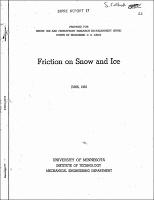Please use this identifier to cite or link to this item:
https://hdl.handle.net/11681/6012Full metadata record
| DC Field | Value | Language |
|---|---|---|
| dc.contributor.author | University of Minnesota. Department of Mechanical Engineering | - |
| dc.date.accessioned | 2016-03-21T21:14:59Z | - |
| dc.date.available | 2016-03-21T21:14:59Z | - |
| dc.date.issued | 1955-06 | - |
| dc.identifier.uri | http://hdl.handle.net/11681/6012 | - |
| dc.description | Technical Report | - |
| dc.description | Abstract: Frictional resistance on ice and snow was examined in terms of current frictional theories. It was concluded that a liquidlike film of some type exists or is formed on the ice surface. The basic mechanism forming this film is either the frictional heating mechanism suggested by Bowden, or is electrical in nature as suggested by Weyl. A “Stick-Slip” friction measuring apparatus was constructed and its vibratory characteristics analyzed. Experimental measurements were made of the static and kinetic friction under various conditions of load, apparent area, slider material, temperature, humidity, time of stationary contact, and carriage velocity. Statistical analysis of experimental data indicated that time of stationary contact, temperature, humidity, apparent area and material characteristics had significant influence upon the frictional resistance. Within the range of carriage velocities investigated, the magnitude of the velocity had no appreciable influence on the kinetic friction. Oscillographs taken of the intermittent stick-slip motion of sliders on ice provided the basis for certain deductions regarding the influence of time on fractional resistance. It was concluded that merely bringing a slider momentarily to rest is not sufficient to obtain static friction. A short but finite period of time is required to obtain static friction, the frictional resistance rising to very high values (freezedown) following fairly long periods of stationary contact. Measurements of the electrical resistance and capacitance between a slider and an electrode frozen within the ice provided information regarding the contact area characteristics. Radioactive studies of the frictional process indicated a maximum transfer of ice to slider during the stick portion of the stick-slip motion. | - |
| dc.publisher | U.S. Army Snow, Ice, and Permafrost Research Establishment. | - |
| dc.publisher | Engineer Research and Development Center (U.S.) | - |
| dc.relation | http://acwc.sdp.sirsi.net/client/en_US/search/asset/1021800 | - |
| dc.relation.ispartofseries | SIPRE report ; 17. | - |
| dc.rights | Approved for public release; distribution is unlimited. | - |
| dc.source | This Digital Resource was created from scans of the Print Resource | - |
| dc.subject | Friction | - |
| dc.subject | Snow | - |
| dc.subject | Ice | - |
| dc.subject | Measurement | - |
| dc.subject | Theory k | - |
| dc.title | Friction on snow and ice | - |
| dc.type | Report | en_US |
| Appears in Collections: | Technical Report | |
Files in This Item:
| File | Description | Size | Format | |
|---|---|---|---|---|
| SIPRE-Technical-Report-17.pdf | 27.95 MB | Adobe PDF |  View/Open |